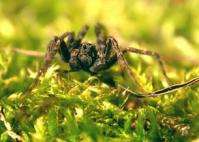Spider man looks for answers in the forest

Dave Shorthouse admits he's obsessed with spiders, so it wasn't at all unusual for him to spend two years in the forests of the Peace River country, collecting and counting the critters for the good of the environment.
The biological sciences PhD student at the University of Alberta spent a chunk of his childhood in Ontario romping with the family dogs in the woods behind his home, looking for spiders. Love 'em or hate 'em, everybody knows them, and that's part of the appeal for Shorthouse. "I just step back and listen to anyone's conversation. We all have a spider story."
He was in his third year of a degree at Carleton University when he sat through a lecture on spiders during an entomology course. "That's when the light bulb went on and I became fascinated with the sheer diversity of them. And we know so little about them."
There are 1,500 to 1,600 species of spiders in Canada, of all shapes and sizes. To earn his PhD in biology, Shorthouse is examining the diversity of spiders in the Clear Hills forest in the Peace River and Hinton areas of Alberta, as a way to help forestry companies find the best methods to reclaim harvested land.
By determining how many different spider species are living on reclaimed land, companies can work on a plan on how to best harvest their timber, Shorthouse said. In his research, Shorthouse worked on lands that had been set aside for research purposes by Daishowa-Marubeni International Ltd. He set 850 plastic beer-style cups 14 centimetres deep into the forest floor in an area that spanned an area 10 by five kilometres.
He found that 183 different species tumbled into his cups - that's an astounding 45,000 spiders, which sounds like a lot, but is really "just a drop in the bucket," Shorthouse said.
He also discovered after counting and identifying the spiders, that there was less diversity in clearcut forest. The creatures tended to run in circles in these areas as Shorthouse learned when he went back into the field to track them. "In undisturbed forest, they moved in more of a linear direction." He's unsure why this is the case, but says this change in behaviour helps explain why there is a low diversity of spider species.
"I found a prevalence of three or four different species in clearcut forest where there should have been 100 species. It's no good to have half a dozen species, but thousands of one and very few of another."
It's believed that high diversity is linked to high productivity in a habitat, "a place where species can flourish," he said.
Spiders, which sit at the top of their food chain, not only control insect populations in a healthy forest community, but they also serve as food for birds.
The prevalent family of spiders Shorthouse found in the Clear Hills forests cups was the wolf spider, which numbered 65 hairy-legged hunting species. The forest is also home to money spiders, so-named for the old British legend that if you found one in the cupboard, it was weaving a pouch of money. But it yielded a different bonus during Shorthouse's study - one of discovery, when he found a new species of the family in 2002. It has since been entered into the Canadian National Collection in Ottawa.
Shorthouse, who is in the process of writing his thesis, will use his findings to help forestry companies find the most environmentally responsible way to harvest trees. He's been developing predictive equations that Daishowa-Marubeni International can plug into its computers to create what-if scenarios for different ways of logging.
"It helps them do their very difficult job," said Shorthouse. Forestry companies are under increasing regulatory and market pressure to harvest trees in an ecologically responsible manner, but the playbook guiding their decisions is incomplete, so information like this helps, he said.
Shorthouse is a champion for the crawly critters in other ways, too. Besides his PhD research, he runs the Nearctic Spider Database, a North American site where he compiles data sent in by collectors and curators. He also edits the Canadian Arachnologist, a newsletter that circulates in Canada and the United States. To raise funds for both those projects, he recently conducted a public competition for spider pictures. The winners are featured in a 2007 calendar.
He can also dispel a few myths about spiders - for one, Daddy Longlegs, which aren't a spider at all but members of a different order of arachnids, called Opiliones. They are not venomous and can't puncture human skin. Female spiders don't lay eggs in human ears. And there are no documented cases of anyone in North America perishing from the bite of a Black Widow spider. (There are only about six species in Canada whose venom is potent enough to harm humans.) What most people mistake for a spider bite is usually just an allergic reaction to something else.
"And here's the big one: 99 per cent of spiders are not in the least bit deadly. They are only 'poisonous' if you choose to eat a bunch of them," said Shorthouse.
Source: University of Alberta

















